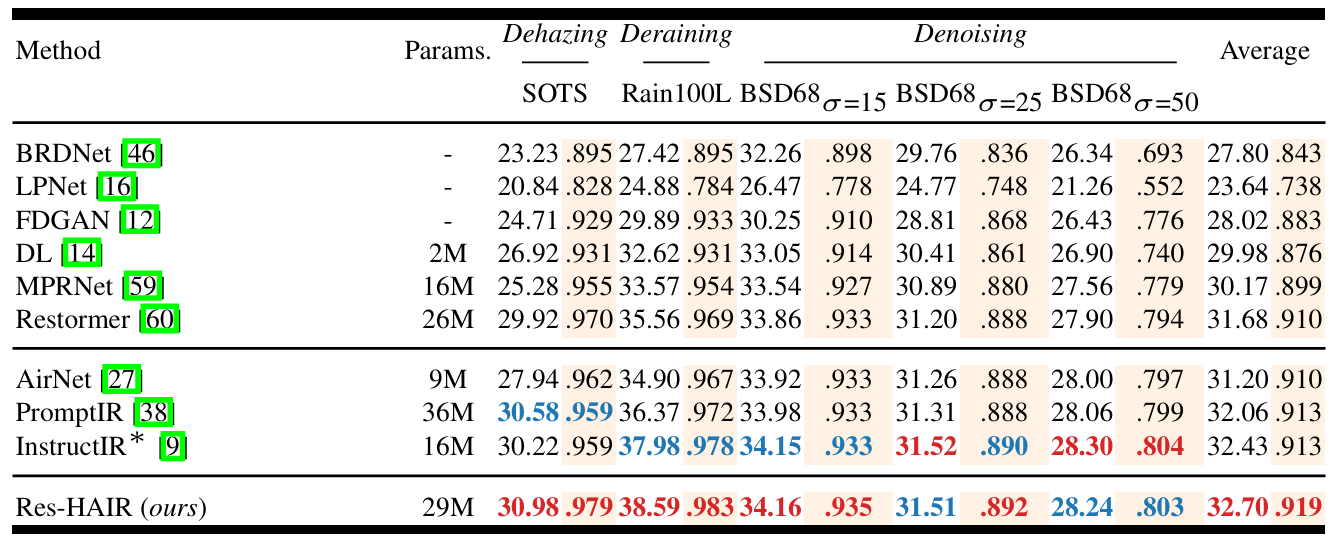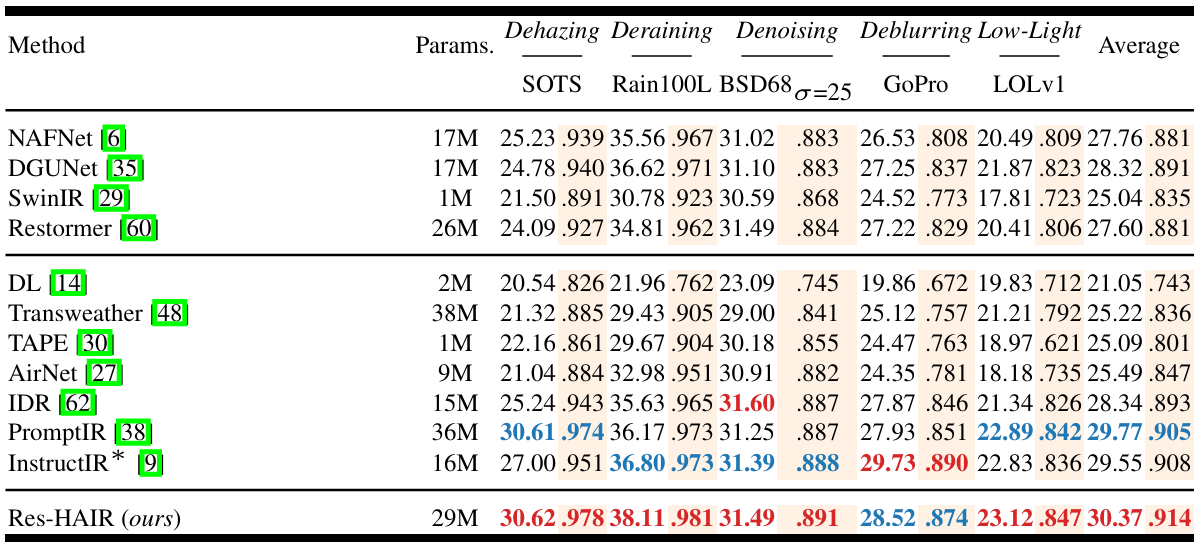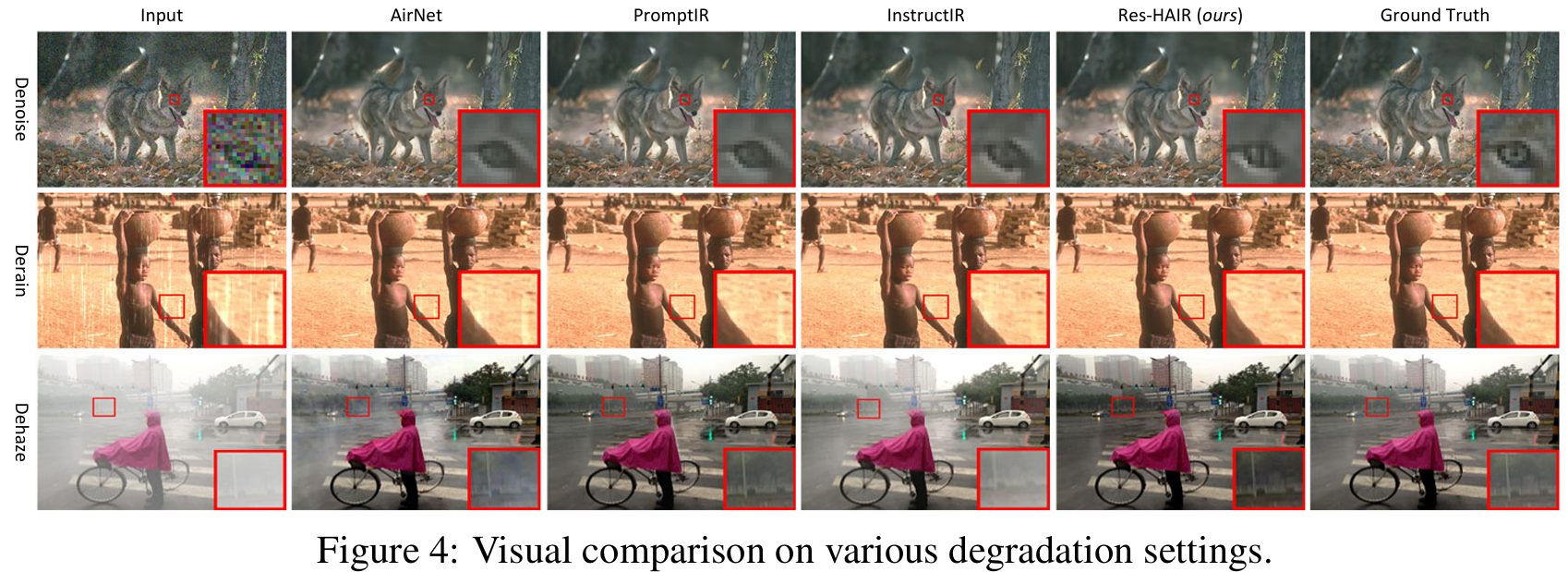Abstract: Image restoration aims to recover a high-quality clean image from its degraded version. Recent progress in image restoration has demonstrated the effectiveness of All-in-One image restoration models in addressing various degradations simultaneously. However, these existing methods typically utilize the same parameters to tackle images with different degradation types, thus forcing the model to balance the performance between different tasks and limiting its performance on each task. To alleviate this issue, we propose HAIR, a Hypernetworks-based All-in-One Image Restoration method that dynamically generates parameters based on input images. Specifically, HAIR consists of two main components, i.e., Classifier and Hyper Selecting Net (HSN). The Classifier is a simple image classification network used to generate a Global Information Vector (GIV) that contains the degradation information of the input image, and the HSN is a simple fully-connected neural network that receives the GIV and outputs parameters for the corresponding modules. Extensive experiments demonstrate that HAIR can significantly improve the performance of existing image restoration models in a plug-and-play manner, both in single-task and all-in-one settings. Notably, our innovative model, Res-HAIR, which integrates HAIR into the well-known Restormer, can obtain superior or comparable performance compared with current state-of-the-art methods. Moreover, we theoretically demonstrate that our proposed HAIR requires fewer parameters in contrast to the prevalent All-in-One methodologies.
🔥 New SOTA for all-in-one image restoration on a range of tasks, including Dehaze, Denoise, Derain, Deblur, Low-light Enhancement, etc. Please give us a star ★ if you find this work interesting.
- 2024.8.16: Release raw codes without comments.
See INSTALL.md for the installation of dependencies and dataset preperation required to run this codebase. (Note that this repository is prepared for 3-degradation setting. For 5-degradation setting, please refer IDR.
After preparing the training data in data/ directory, use
python train.py
to start the training of the model. Use the de_type argument to choose the combination of degradation types to train on. By default it is set to all the 3 degradation types (noise, rain, and haze).
Example Usage: If we only want to train on deraining and dehazing:
python train.py --de_type derain dehaze
After preparing the testing data in test/ directory, place the mode checkpoint file in the ckpt directory. The pretrained model can be downloaded here, alternatively, it is also available under the releases tab. To perform the evalaution use
python test.py --mode {n}
n is a number that can be used to set the tasks to be evaluated on, 0 for denoising, 1 for deraining, 2 for dehaazing and 3 for all-in-one setting.
Example Usage: To test on all the degradation types at once, run:
python test.py --mode 3
To obtain visual results from the model demo.py can be used. After placing the saved model file in ckpt directory, run:
python demo.py --test_path {path_to_degraded_images} --output_path {save_images_here}
Example usage to run inference on a directory of images:
python demo.py --test_path './test/demo/' --output_path './output/demo/'
Example usage to run inference on an image directly:
python demo.py --test_path './test/demo/image.png' --output_path './output/demo/'
To use tiling option while running demo.py set --tile option to True. The Tile size and Tile overlap parameters can be adjusted using --tile_size and --tile_overlap options respectively.
Performance results of the Res-HAIR framework trained under the all-in-one setting
Performance
If you use our work, please consider citing:
@misc{cao2024hair,
title={HAIR: Hypernetworks-based All-in-One Image Restoration},
author={Jin Cao and Yi Cao and Li Pang and Deyu Meng and Xiangyong Cao},
year={2024},
eprint={2408.08091},
archivePrefix={arXiv},
primaryClass={cs.CV},
url={https://arxiv.org/abs/2408.08091},
}
Should you have any questions, please contact 2213315515@stu.xjtu.edu.cn.
Acknowledgment: This repository is highly based on the PromptIR repository, thanks for the great work.





